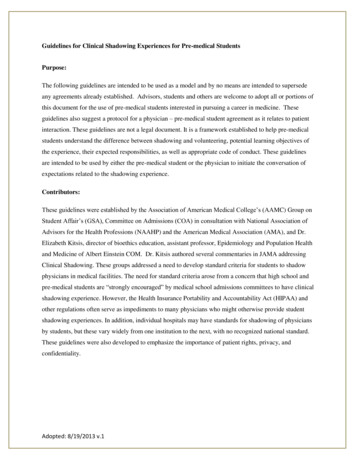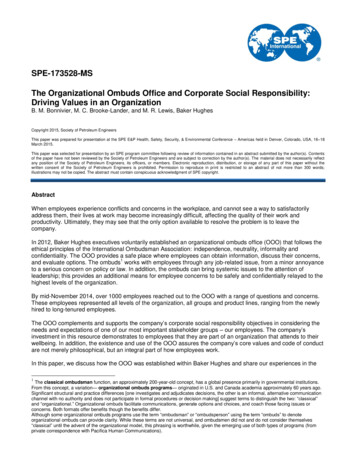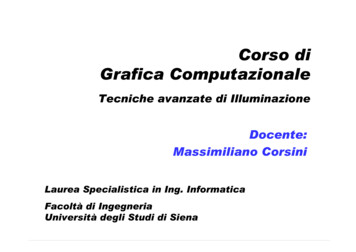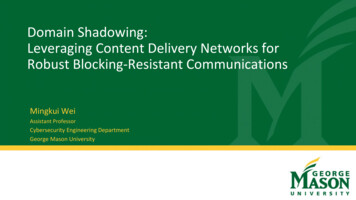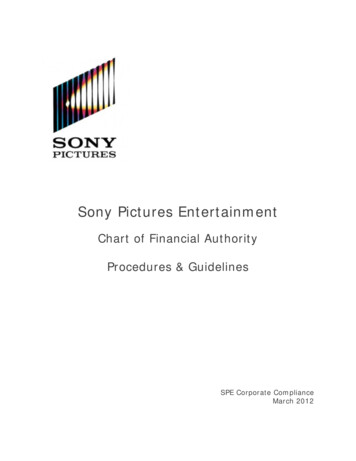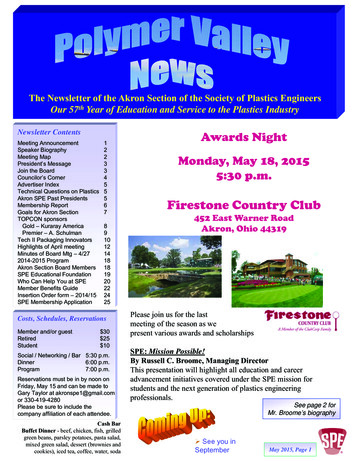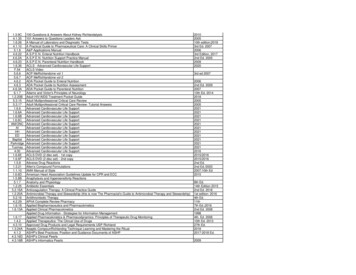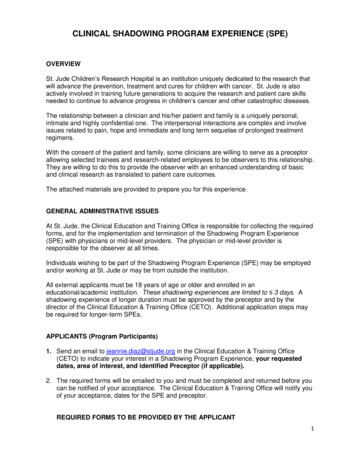
Transcription
CLINICAL SHADOWING PROGRAM EXPERIENCE (SPE)OVERVIEWSt. Jude Children’s Research Hospital is an institution uniquely dedicated to the research thatwill advance the prevention, treatment and cures for children with cancer. St. Jude is alsoactively involved in training future generations to acquire the research and patient care skillsneeded to continue to advance progress in children’s cancer and other catastrophic diseases.The relationship between a clinician and his/her patient and family is a uniquely personal,intimate and highly confidential one. The interpersonal interactions are complex and involveissues related to pain, hope and immediate and long term sequelae of prolonged treatmentregimens.With the consent of the patient and family, some clinicians are willing to serve as a preceptorallowing selected trainees and research-related employees to be observers to this relationship.They are willing to do this to provide the observer with an enhanced understanding of basicand clinical research as translated to patient care outcomes.The attached materials are provided to prepare you for this experience.GENERAL ADMINISTRATIVE ISSUESAt St. Jude, the Clinical Education and Training Office is responsible for collecting the requiredforms, and for the implementation and termination of the Shadowing Program Experience(SPE) with physicians or mid-level providers. The physician or mid-level provider isresponsible for the observer at all times.Individuals wishing to be part of the Shadowing Program Experience (SPE) may be employedand/or working at St. Jude or may be from outside the institution.All external applicants must be 18 years of age or older and enrolled in aneducational/academic institution. These shadowing experiences are limited to 3 days. Ashadowing experience of longer duration must be approved by the preceptor and by thedirector of the Clinical Education & Training Office (CETO). Additional application steps maybe required for longer-term SPEs.APPLICANTS (Program Participants)1. Send an email to jeannie.diaz@stjude.org in the Clinical Education & Training Office(CETO) to indicate your interest in a Shadowing Program Experience, your requesteddates, area of interest, and identified Preceptor (if applicable).2. The required forms will be emailed to you and must be completed and returned before youcan be notified of your acceptance. The Clinical Education & Training Office will notify youof your acceptance, dates for the SPE and preceptor.REQUIRED FORMS TO BE PROVIDED BY THE APPLICANT1
Curriculum Vita or ResumePersonal Statement indicating why the Shadowing Program Experience is requestedLetter of Recommendation from a senior official in the applicant’s academic institutionor current supervisor if working at St. JudeREQUIRED HOSPITAL FORMS Immunization statement signed by your primary care provider * (P. 16)Substance Abuse & Felony/Misdemeanor Charges (Form V) statement signed byprogram participant * (P. 17)Hospital Agreement & Consent for Participation Statement completed by programparticipant and preceptor (P. 18-21)3. The attached Policies & Procedures and HIPAA Training Module must be reviewed beforeyour SPE. A brief quiz on this material is included as part of the SPE application.4. All forms should be returned to:Jeannie DiazMedical Education CoordinatorSt. Jude Children’s Research Hospital262 Danny Thomas Place, MS 277Memphis, TN 38105jeannie.diaz@stjude.org* If you are a St. Jude employee or are working at St. Jude as part of an educationalprogram (e.g. Rhodes Summer Plus Program), then you are not required complete theseforms.2
Packet InformationI. Mission Statement and History * . 4II. Hospital Policies & Procedures Relative to the Shadowing Program Experience *52. Compensation and Benefits Acknowledgement . . 3. Confidential Information . . 4. Drug-free Workplace .5. Dress Code .6. Electrical Safety .7. Emergency Announcements .8. Emergency Preparedness .9. Harassment .5555567710. Infection Control .711. Injuries During Participation .712. Interacting with Patients and Families .713. Internet and Email Policies Acknowledgement .814. Non-sectarian Institution 815. Performance Improvement 816. Prohibited Conduct Acknowledgement 917. Radiation Safety .918. Relationships with Patients and Families 919. Security and Parking .1020. Questions .10III. HIPAA Training Module . 11-15IV. Immunization History to be completed by Primary Care Provider 16V. Substance Abuse, Felony or Misdemeanor Charges (signed by ProgramParticipant) 17VI. Hospital Agreement and Consent for Participation in the Shadowing ProgramExperience (SPE) (Signed by Preceptor and Program Participant .18-21VII. Family Observer Information and Consent Form (to be used by Preceptors attheir discretion) 22* We thank the St. Jude Children’s Research Hospital Volunteer Office for providing most of thisinformation.3
I.MISSION STATEMENT AND HISTORYMISSION STATEMENTThe mission of St. Jude Children’s Research Hospital is to advance cures, and means ofprevention, for pediatric catastrophic diseases through research and treatment. Consistentwith the vision of our founder, Danny Thomas, no child is denied treatment based on race,religion or a family’s ability to pay.HISTORYSt. Jude Children’s Research Hospital is the result of a promise made by our late founderDanny Thomas. Almost 60 years ago, Thomas, then a struggling young entertainer withonly seven dollars in his pocket, knelt in a Detroit church before a statue of St. JudeThaddeus, the patron saint of hopeless causes. Danny Thomas prayed, “Show me myway in life.” His prayer was answered, and soon he moved his family to Chicago to pursuenew career offers. A few years later, at another turning point in his life, Thomas againprayed to St. Jude Thaddeus and pledged to someday build a shrine to the saint. He didnot forget his promise. As his career prospered through films and television, Thomas,together with his mentor, the late Cardinal Samuel Stritch of Chicago, decided that hisshrine to St. Jude Thaddeus should be a hospital in Memphis where children would becared for regardless of their race, religion or ability to pay.Along with local business leaders and friends in the entertainment industry, Thomas raisedthe money to build the hospital by the mid-1950s. But where would the money come fromto fund the hospital’s annual operation? Thomas turned to his fellow Americans of Arabicspeaking heritage. He believed deeply that this group should thank the United States forthe gifts of freedom given their parents. Thomas also felt that supporting the hospitalwould be a noble way of honoring their immigrant forefathers.In 1957, 100 representatives of the Arab-American community met in Chicago to formALSAC (American Lebanese Syrian Associated Charities) with the sole purpose of raisingfunds to support St. Jude Children’s Research Hospital.ALSAC/St. Jude continues to fund Danny Thomas’ dream today by raising more than 800million a year. It is America’s second largest health care charity. At St. Jude, no familyever pays for treatments not covered by insurance, and families without insurance arenever asked to pay.St. Jude is one of the world’s premier centers for the research, treatment and prevention ofcatastrophic diseases in children.Working together, St. Jude physicians have rewritten the medical textbooks that oncecategorized acute lymphoblastic leukemia (ALL), certain tumors, bone cancers and otherdiseases as virtually incurable. Because of the dramatic progress made at St. Jude,thousands of children are living today who could not have survived their diseases ageneration ago. And because the treatment protocols developed at St. Jude are freelyshared with the medical community everywhere, one child saved at St. Jude representsthousands of children saved around the world.4
II.HOSPITAL POLICIES & PROCEDURESRead the attached information regarding hospital Policies & Procedures. By signing theConsent for Participation form (P. 18), observers agree to abide by these standards whileparticipating in the Shadowing Program Experience. COMPENSATION AND BENEFITS ACKNOWLEDGMENTSPE program participants will not receive the compensation and benefits package that isoffered to regular St. Jude employees. CONFIDENTIAL INFORMATIONThe privacy of all patients and their families must be protected. Information concerning thename, treatment or condition of a patient is strictly confidential. Any necessary discussionabout a patient must be held where it cannot be overheard. Discussions about patientscan only take place with your preceptor. You must not share even the fact that the patientis hospitalized with anyone and especially with friends and family. If the observer breaks aHIPAA rule, he/she will be asked to leave immediately and the preceptor may experienceserious consequences. DRUG-FREE WORKPLACESt. Jude Children’s Research Hospital is committed to maintaining a workplace free fromthe influence of alcohol and drugs including nicotine. Hospital policy prohibits the use,possession, manufacture, distribution or sale of drugs and alcohol on hospital property.Smoking is not allowed anywhere on the St. Jude campus. DRESS CODESt. Jude Children’s Research Hospital dress code and professional behavior standardsapply to observers who come on site for this program. The personal appearance of eachstudent is a reflection of the professional atmosphere of St. Jude. All students areexpected to dress in a clean, neat and professional fashion.The Department Head/Chair may institute dress codes within a specific department toensure compliance with the standards of OSHA, the Health Department, other regulatoryagencies or the needs of the department.Students may not wear garments to St. Jude that may be distracting, unusually revealingor unsafe, or clothing that endorses a product or suggests offensive sexual, racial,religious, age-related, ethnic or disability-related subject matter. Open-toed shoes, tanktops, blue jeans, caps/beanie hats, exposed midriffs, nail polish, hanging jewelry, visibletattoos, and face piercings are prohibited.Scented products should not be worn in areas where students may have patient contact;this includes general gathering areas such as the cafeteria or meeting rooms. ELECTRICAL SAFETYInspect all electronic equipment before using and note if there is an unusual smell comingfrom the item. Do not handle electrical cords that look frayed or damaged. Reportdamaged equipment to Biomedical Engineering at ext. 3392.5
EMERGENCY ANNOUNCEMENTSDr. Red: Fire – If you discover fire or smoke, follow the R.A.C.E. formula R - RESCUE anyone in immediate dangerA - ACTIVATE the nearest fire alarm and if time allows, call the PBX operator at ext.3499. Identify the fire’s location in a calm voiceC - CONTAIN the fire by closing the door to the room where the fire is locatedE - EXTINGUISH or evacuateThe operator will announce three times over the hospital PA system: “Dr. Red, andreport the fire’s exact location, e.g. “Research Tower, 4th floor, Rm. 4004”Always familiarize yourself with your surroundings and know where the nearest firealarm box and fire extinguisher are located.How to use the fire extinguisher: follow the P.A.S.S. plan P - PULL the pin outA - AIM the nozzle at the base of the fireS - SQUEEZE the handleS - SWEEP from side to sideDr. Red Major: EvacuationThe decision to evacuate any area(s) or any building(s) is a very serious one. Thisdecision will be made by the most competent hospital authority or the city fire chief at thescene of the fire. If evacuation is required, the PBX operator will be notified. The order toevacuate will be announced several times over the PA system as, “Dr. Red Major,” and willreport exact location, e.g., “Ambulatory Care Unit.” The fire bells will sound. The FireResponse Team controls the evacuation process, and you should follow the evacuationplan in the area where you are.If an entire building is ordered to evacuate, you should walk to the first floor andexit to the outdoors. Use of elevators during a fire or evacuation is dangerous and is notallowed. Please follow the instructions of the Fire Response Team at all times.In areas not affected by the fire Keep calm and listen carefully to the PA system for further instructionsKeep off the telephones except for emergency calls. Unnecessary use may hampercommunications and movement to the fire areaKnow your fire duties, as well as your fire evacuation routeUnless absolutely necessary, do not travel from one area to the next. Do not open firedoors unnecessarilyDr. Green: Conclusion of the fire plan activityWhen the situation is clear, and upon notification from the senior fire warden (director ofFacilities Management) or his/her assistant, the operator will announce over the PAsystem, “Dr. Green, All Clear” three times in succession. The operator will also page“0888” and state “Dr. Green, All Clear.”Dr. Child: Abducted childIf a child is missing or abducted, the PBX operator will announce “Dr. Child,” followed by6
a description of the child, over the PA system. If you have seen the child or can provideany information regarding the abduction, call Security at ext. 4444. EMERGENCY PREPAREDNESSFor all emergencies, the PBX operator may be reached at ext. 3499. Report the type ofemergency and the location. The phone number for Security is ext. 4444. Report anysuspicious person or crime immediately. Use the R.A.C.E. and P.A.S.S. proceduresdescribed above for fire emergencies. HARASSMENTSt. Jude will not permit or condone any form of harassment, including harassment basedon race, color, religion, sex, national origin, age or disability. Remarks, touching, or writtenor graphic material related to race, color, religion, gender, national origin, age, maritalstatus or disability are not permitted. Unwelcome sexual propositions, suggestive remarks,jokes or stories with sexual overtones, and sexually explicit comments are not permitted. INFECTION CONTROLProgram participants should not report when ill because of the risk of transmitting theinfection to patients, families or employees. Specifically, persons should not report with afever, shingles, boils, infected lesions anywhere on the body, conjunctivitis (“pink eye”), orany respiratory or gastrointestinal symptoms.Hand washing is the most effective method of preventing the spread of infection. Thepalms, backs of the hands, in between the fingers and the fingernails should be washedwith antimicrobial soap for at least 10 seconds while vigorously rubbing them under water.Program participants observing on inpatient floors must wash their hands before enteringand exiting each patient room.If there has been a spill or a patient has been vomiting or had diarrhea, do not touch it.Notify your preceptor. Call Environmental Services at ext. 3393.If it becomes necessary for a program participant to enter a patient isolation room, he/sheshould always check with the preceptor before entering the room and follow isolationprecautions as directed. INJURIES DURING PARTICIPATIONIf you are injured while you are observing at St. Jude, you must fill out an Injury Report.These forms can be obtained from your preceptor. After completing the form, give it toyour preceptor. INTERACTING WITH PATIENTS AND FAMILIESThe Joint Commission on Accreditation of Healthcare Organizations requires that allemployees, volunteers, and observers who work with or around patients understand howto deal with different age groups. This is what is referred to as “characteristics ofpopulations served or age-competencies.” This knowledge is essential for providing careto specific age groups. Following are the Environment of Care Competencies for the agegroups seen by St. Jude:For all ages Introduce yourself, tell why you are there and wear your name tagAsk for names of patients and family members, then use themTake emotions, feeling and ideas seriously7
Maintain a positive attitudeBe honestKeep confidential information to yourselfBe creative—everyone loves to laugh and feel goodRespect and privacy are importantRecognize that all persons have equal valueFor children Play is a child’s work—encourage and support itEach child is an individual—comparisons to others can hurtStaring, pointing or whispering about children who look or act different hurts theirfeelingsFor Parents / AdultsMajor fears: The unknown, loss of control, loss of values that are important to thefamily, and death Characteristicso Concerned about the child’s problemso May feel overwhelmed and frightened or withdrawn and depressedo Responsible for financial and household matters Tips for interactiono Use regular words instead of medical words or slango Too much information or advice is overwhelmingo Give recognition and praise for their strengthso If a parent believes a problem exists, then it doeso Listen carefully to what they are sayingo Encourage questions INTERNET AND EMAIL POLICIES ACKNOWLEDGMENTAll electronic communications sent, received or stored on the St. Jude Internet system arethe sole and exclusive property of St. Jude Children’s Research Hospital.St. Jude security software may record for management use the Internet address of any sitevisited and may keep a record of any network activity in which any kind of file is transmittedor received. In the event there is a reasonable belief that hospital policy has been violated,the hospital reserves the right to inspect any and all files stored within the hospitalnetworks to assure compliance with hospital policy. NON-SECTARIAN INSTITUTIONThe hospital’s founder, Danny Thomas, opened the hospital to children of all religions.Sharing of personal beliefs and materials, performances or literature of a religious nature isnot permitted. PERFORMANCE IMPROVEMENTWe want you to be familiar with our Performance Improvement philosophy because allservices, departments and divisions at St. Jude use this plan. The goal of PerformanceImprovement is to assist the organization in the definition, measurement, analysis,monitoring, and awareness of pediatric standards of service and excellence in order to8
continually improve the quality of patient care, family satisfaction and institutionalperformance. The model St. Jude uses is FOCUS-PDCA (Find a process, Organize toimprove, Clarify current knowledge, Understand variation, Select improvements – Plan,Do, Check, Act). PROHIBITED CONDUCT FOR PARTICIPANTS IN THE SHADOWING PROGRAMEXPERIENCESt. Jude reserves the right to remove a student immediately from the SPE if the student’sactions could harm a patient, a patient’s family member, an employee, or a St. Jude visitor.1.2.3.4.5.6.Reporting to observation experience under the influence of alcohol or drugsUse or consumption of alcohol or other intoxicating substances on hospital premisesSelling or distributing illegal substances while on hospital premisesStealing from patients, the hospital, or employeesAny form of dishonestyDisorderly conduct, including fighting, acting in an obscene manner or using obscene,abusive or threatening language, or horseplay7. Smoking in an area where smoking is prohibited8. Defacing or damaging hospital property9. Possession or use of firearms, fireworks, or any other weapon on hospital property10. Excessive use of hospital telephones or other hospital equipment for personal matters11. Disobeying safety regulations12. Insubordination13. Noncompliance with hospital policies and/or failure to observe hospital securityregulations14. Failure to maintain the confidentiality of hospital matters pertaining to patients15. Any action that destroys good relations between the hospital and its employees or anysuppliers or patients16. Harassment of any kind (i.e. sexual, racial, age, etc.) RADIATION SAFETYRadiation safety personnel monitor the receipt, use and disposal of all radiation suppliesto ensure a safe working environment and compliance with federal and state regulations.Signs are posted on laboratories and patient rooms in which radioactive materials arebeing used. Do not enter any such area without the permission and knowledge of thearea’s supervisor. Program participants working in areas using radioactive materials mustwork under the direct supervision of a trained St. Jude employee. Questions aboutradiation safety and/or radioactive materials should be directed to the Radiation Safetyoffice at ext. 2314. RELATIONSHIPS WITH PATIENTS AND FAMILIESIt is important for you to establish healthy relationships and to set firm boundaries ofappropriate conduct when interacting with patients and families. This is for the protectionof the patient, patient’s family and for you, the program participant. It helps strengthen ourpatients’ and families’ ability to conduct their lives during a difficult time.We operate under the premise that what we do for one, we will do for all. This will helpguide you through some potentially difficult situations.Examples of INAPPROPRIATE activities are: Accepting personal gifts from patients or families. The only exception to the rule is if itis a handmade craft or drawing. Any gift purchased from a store or that is of value9
should be politely refusedBuying gifts for individual patients or families regardless of your relationship with themSharing personal information, personal contact information or personal problems withpatients or familiesCalling the staff or patients on your off days to check on how they are doingLoaning or borrowing money or personal belongings to or from patients or familiesTaking photographs or videos of patients or families for personal useGiving patients or families a ride in your vehicleInviting patients or families to off-campus activities or accepting an invitation to theirhomeUsing off time to baby sit or to sit with a family during a stressful surgeryAttending a worship service with patients and families or inviting them to your place ofworshipOffering your family as a socialization option for a patient and /or patient’s siblingsGiving patients or families non-prescription medication from your personal supplyAgreeing to plan a patient’s funeralTelling a patient that your time is more needed today with another patient who ishaving a difficult timeBringing your family members or friends to a hospital event for patients and familiessuch as picnics or memorial servicesSharing information about one patient with another patient or familySECURITY AND PARKINGTemporary identification badges are to be worn at all times and visibly displayed above thewaist for security and personal identification purposes.St. Jude offers free parking to all program participants. Participants must check-in with thesecurity guard at the entrance gate each day of the SPE. Participants will be given atemporary parking permit each time they are on campus.St. Jude is not responsible for the loss of or damage to personal property or valuables.Please notify Security of any missing items, forced locks or suspicious people or packages.Security can be reached at ext. 4444. QUESTIONSContact Clinical Education & Training Office (CETO) at (901)595-6385 or emailjeannie.diaz@stjude.org.10
III.HEALTH INFORMATION PORTABILITY AND ACCOUNTABILITY ACT (HIPAA) –Privacy and Security Training Relative to the Shadowing Program Experience1. IntroductionAs a student in a clinical training program or participating in a Shadowing ProgramExperience or other educational experience within St. Jude Children’s Research Hospitalyou are required to learn about the health information privacy and security requirements ofa federal law called HIPAA (Health Insurance Portability and Accountability Act of 1996).The health information privacy and security requirements are known as the HIPAA PrivacyRule and Security Rule went into effect in 2003 & 2005. When you are at a health carefacility for clinical training or other educational experiences, you are covered by the Privacyand Security Rules as a member of that facility's workforce. In addition to this training,your training site or school may require you to complete on the job Privacy and SecurityRules training specific to your experience at that site. When you are at St. Jude, you mustfollow the policies and procedures, including those concerning health information privacyand security. Thank you for taking time to learn about the HIPAA Privacy and SecurityRules.2. The HIPAA Privacy RuleThe Privacy Rule defines how health care providers, staff, trainees and students in clinicaltraining programs can use, disclose, and maintain identifiable patient information, called"Protected Health Information" ("PHI"). PHI includes written, spoken, electronicinformation and images and any other medium. PHI is health information (treatment relatedinformation) or health care payment information that identifies or can be used to identify anindividual patient. PHI very broadly defines identifiers to include not only patient name,address, and social security number, but also, for example, fax numbers, email addresses,vehicle identifiers, URLs, photographs, and voices or images on tape or electronic media.When in doubt, you should assume that any individual health information is protectedunder HIPAA. All patients you come into contact with at St. Jude will have received aNotice of Privacy Practices, which describes in detail permitted uses and disclosures ofPHI and patient rights (discussed below) under HIPAA.3. Important DefinitionsUSE: the sharing, application, utilization, examination, or analysis of PHI by employeesand trainees within St. Jude.DISCLOSURE: discussing PHI with or providing copies of PHI to persons who are notemployees or trainees of St Jude.You may use PHI, without patient authorization, (a specialized and signed patientpermission) at St. Jude for purposes of treatment. However, you may not furtherdisclose PHI in any form to anyone outside of St. Jude, without first obtainingwritten patient authorization or de-identifying the PHI. This means that you may not,for example, discuss or present PHI with or to anyone, including family, classmatesor faculty, who were not directly involved in your training, unless you first obtainwritten authorization from the patient. Therefore, it is strongly recommended thatwhenever possible, you de-identify PHI, as described below, before presenting any patientinformation outside of St. Jude. If you are unable to de-identify such information, you mustdiscuss your need for identifiable information with the faculty member supervising your11
training and St. Jude Privacy Officer, to determine the appropriate procedures for obtainingpatient authorization for your disclosure of PHI.In order for PHI to be considered de-identified, all of the following identifiers of the patientor of relatives, employers, or household members of the patient, must be removed:a. Nameb. Geographic subdivisions smaller than a state (i.e., county, town, or city, street address,and zip code) (note: in some cases, the initial three digits of a zip code may be used)c. All elements of dates (except year) for dates directly related to an individual (includingbirth date, admission date, discharge date, date of death, all ages over 89 and datesindicative of age over 89) (note: ages and elements may be aggregated into a singlecategory of age 90 or older)d. Phone numberse. Fax numbersf. E-mail addressesg. Social security numberh. Medical record numberi. Health plan beneficiary numberj. Account numberk. Certificate/license numberl. Vehicle identifiers and serial numbersm. Device identifiers and serial numbersn. URLso. Internet protocol addressesp. Biometric identifiers (e.g., fingerprints)q. Full face photographic and any comparable imagesr. Any other unique identifying number, characteristic, or codes. Any other information that could be used alone or in combination with other informationto identify the individual4. Safeguarding PHI The Privacy and Security Rules requires you to "safeguard" PHI at St. Jude as well asyour training site or school. Use the following practices to ensure HIPAA compliance.If you see a medical record in public view where patients or others can see it, cover thefile, turn it over, or find another way to protect it.When you talk about patients as part of your training, try to prevent others fromoverhearing the conversation. Whenever possible, hold conversations about patientsin private areas. Do not discuss patients while you are in elevators or other publicareas.When medical records are not in use, store them in designated areas in the patientcare unit.Remove patient documents from faxes and copiers as soon as you can.When you throw away documents containing PHI, follow the facility procedures fordisposal of documents with PHI. St. Jude policy is to shred and safeguard all paperand electronic PHI being disposed of.Never remove the patient's official medical record from the facility.Do not make copies of the patient’s official medical record and remove from St Jude.To complete homework, take appropriate steps to safeguard the PHI outside of thetraining site and properly dispose of any paper that contain any PHI when you are donewith it. (Example assignment papers, etc). You should not leave papers out where12
your family members or others may see or access this information. All materials withPHI should
St. Jude Children's Research Hospital 262 Danny Thomas Place, MS 277 Memphis, TN 38105 jeannie.diaz@stjude.org * If you are a St. Jude employee or are working at St. Jude as part of an educational program (e.g. Rhodes Summer Plus Program), then you are not required complete these forms.


